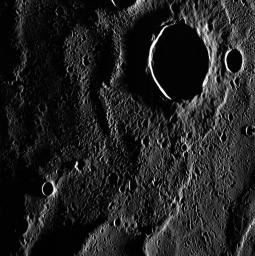Yoshikawa crater, named for Japanese novelist Eiji Yoshikawa, dominates the scene in today's featured image. This crater may host ice-rich deposits within its floor. Though in total shadow when it was imaged here on November 7, 2013, only a portion of the floor is permanently shadowed from the Sun's rays. The crisp rim and well-preserved field of secondary craters surrounding Yoshikawa mean that it is a relatively young crater, and any ice deposits within it must also be relatively young.
This image was acquired as part of MDIS's campaign to image within regions of permanent shadow in ice-bearing polar craters. Imaging with the WAC broadband clear filter, which has a bandwidth of 600 nanometers and is used for calibration imaging of stars, has the potential to reveal details of shadowed surfaces that are weakly illuminated by scattered sunlight. NAC images obtained with long exposure times are also acquired to seek details within shadowed regions. A variety of image exposure times and viewing conditions are employed to maximize the opportunity to resolve surface features of areas in permanent shadow.
Date acquired: November 07, 2013
Image Mission Elapsed Time (MET): 26111757
Image ID: 5150263
Instrument: Wide Angle Camera (WAC) of the Mercury Dual Imaging System (MDIS)
WAC filter: 2 (700 nanometers)
Center Latitude: 80.79°
Center Longitude: 101.1° E
Resolution: 92 meters/pixel
Scale: Yoshikawa crater is approximately 30 km (19 miles) in diameter
Incidence Angle: 88.2°
Emission Angle: 39.2°
Phase Angle: 127.5°
The MESSENGER spacecraft is the first ever to orbit the planet Mercury, and the spacecraft's seven scientific instruments and radio science investigation are unraveling the history and evolution of the Solar System's innermost planet. MESSENGER acquired over 150,000 images and extensive other data sets. MESSENGER is capable of continuing orbital operations until early 2015.
For information regarding the use of images, see the MESSENGER image use policy.

 Planetary Data System
Planetary Data System












